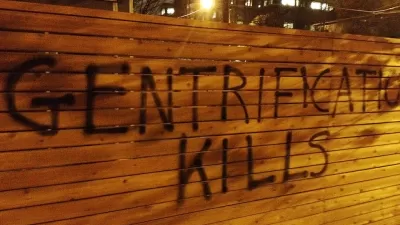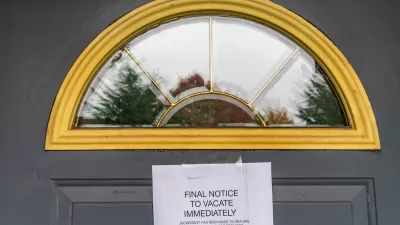About 500,000 tenants face eviction every year—triple previous estimates. And over a million may be involuntary displaced despite never making it to court.

Evictions in California are three times more common than previously thought, according to a new report by statewide renter organization Tenants Together. Using previously unpublished data from the state Judicial Council, the organization found that an average of 166,337 households, averaging 2.9 residents each, received unlawful detainers every year for the last three years.
The analysis also found that, contrary to common belief, "eviction court cases move through the system at breakneck speed." While other civil cases can take years to resolve, state records show that 75 percent of eviction cases are decided within 45 days, and nearly 60 percent within a month.
The data is broken down by county in Tenants Together's report, California Evictions are Fast and Frequent, and visualized in an interactive map by the Anti-Eviction Mapping Project. The report helps fill in the gaps from national data released by the Eviction Lab, led by sociologist Matthew Desmond—which identified only 43,000 evictions in the state last year.
Still, when it comes to displacement, a big piece of the picture is missing: Evictions that occur outside of court. And that may be the majority of cases, the report warns: "For every tenant facing a court filed eviction, there are others displaced from their homes who do not show up in court filing data." The organization estimates that, when all variables are accounted for, over a million tenants might be evicted each year.
FULL STORY: New Tenants Together Report Reveals that Evictions in California are Triple Previous Estimates

Alabama: Trump Terminates Settlements for Black Communities Harmed By Raw Sewage
Trump deemed the landmark civil rights agreement “illegal DEI and environmental justice policy.”

Planetizen Federal Action Tracker
A weekly monitor of how Trump’s orders and actions are impacting planners and planning in America.

The 120 Year Old Tiny Home Villages That Sheltered San Francisco’s Earthquake Refugees
More than a century ago, San Francisco mobilized to house thousands of residents displaced by the 1906 earthquake. Could their strategy offer a model for the present?

In Both Crashes and Crime, Public Transportation is Far Safer than Driving
Contrary to popular assumptions, public transportation has far lower crash and crime rates than automobile travel. For safer communities, improve and encourage transit travel.

Report: Zoning Reforms Should Complement Nashville’s Ambitious Transit Plan
Without reform, restrictive zoning codes will limit the impact of the city’s planned transit expansion and could exclude some of the residents who depend on transit the most.

Judge Orders Release of Frozen IRA, IIJA Funding
The decision is a victory for environmental groups who charged that freezing funds for critical infrastructure and disaster response programs caused “real and irreparable harm” to communities.
Urban Design for Planners 1: Software Tools
This six-course series explores essential urban design concepts using open source software and equips planners with the tools they need to participate fully in the urban design process.
Planning for Universal Design
Learn the tools for implementing Universal Design in planning regulations.
Clanton & Associates, Inc.
Jessamine County Fiscal Court
Institute for Housing and Urban Development Studies (IHS)
City of Grandview
Harvard GSD Executive Education
Toledo-Lucas County Plan Commissions
Salt Lake City
NYU Wagner Graduate School of Public Service





























